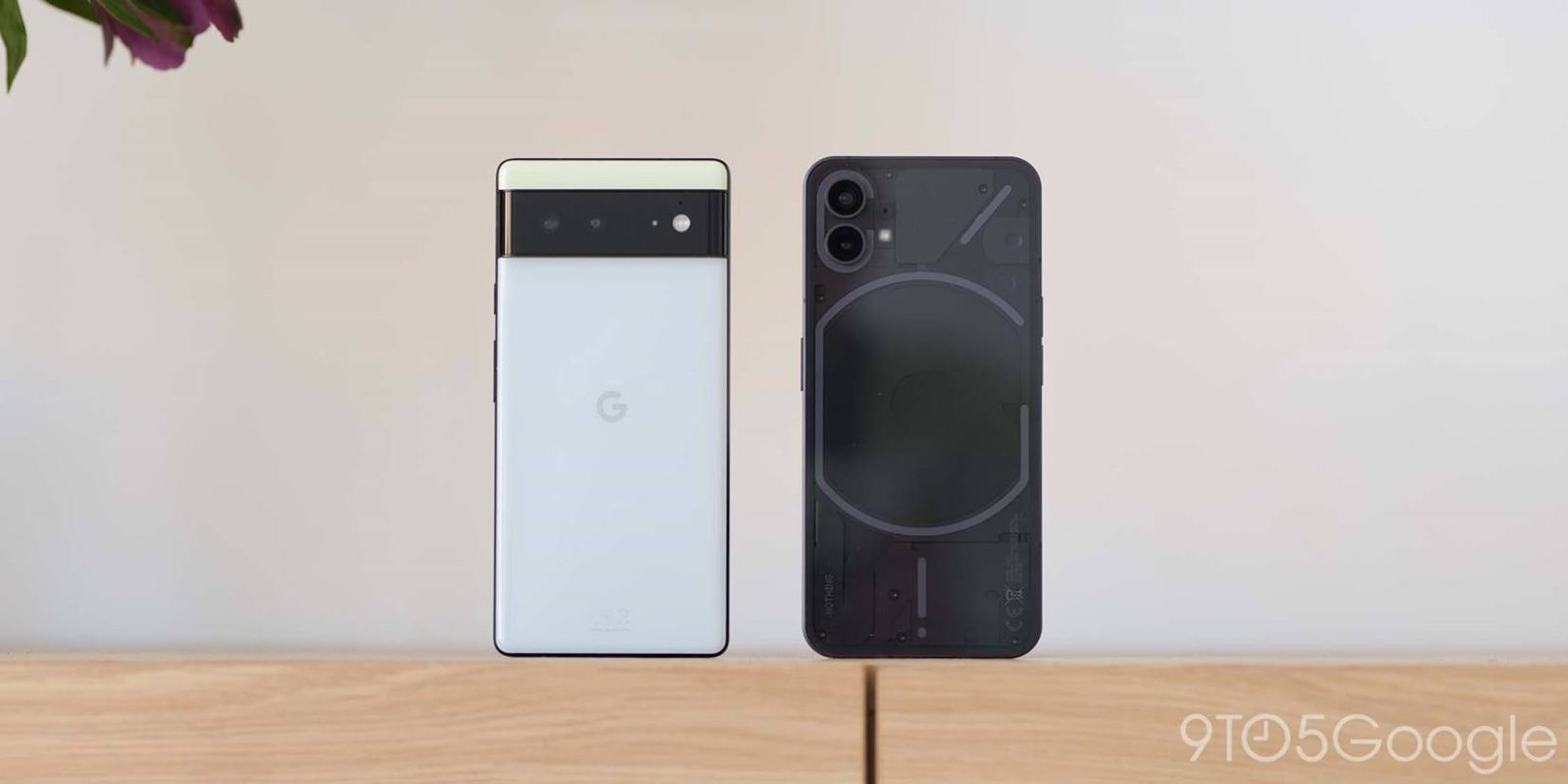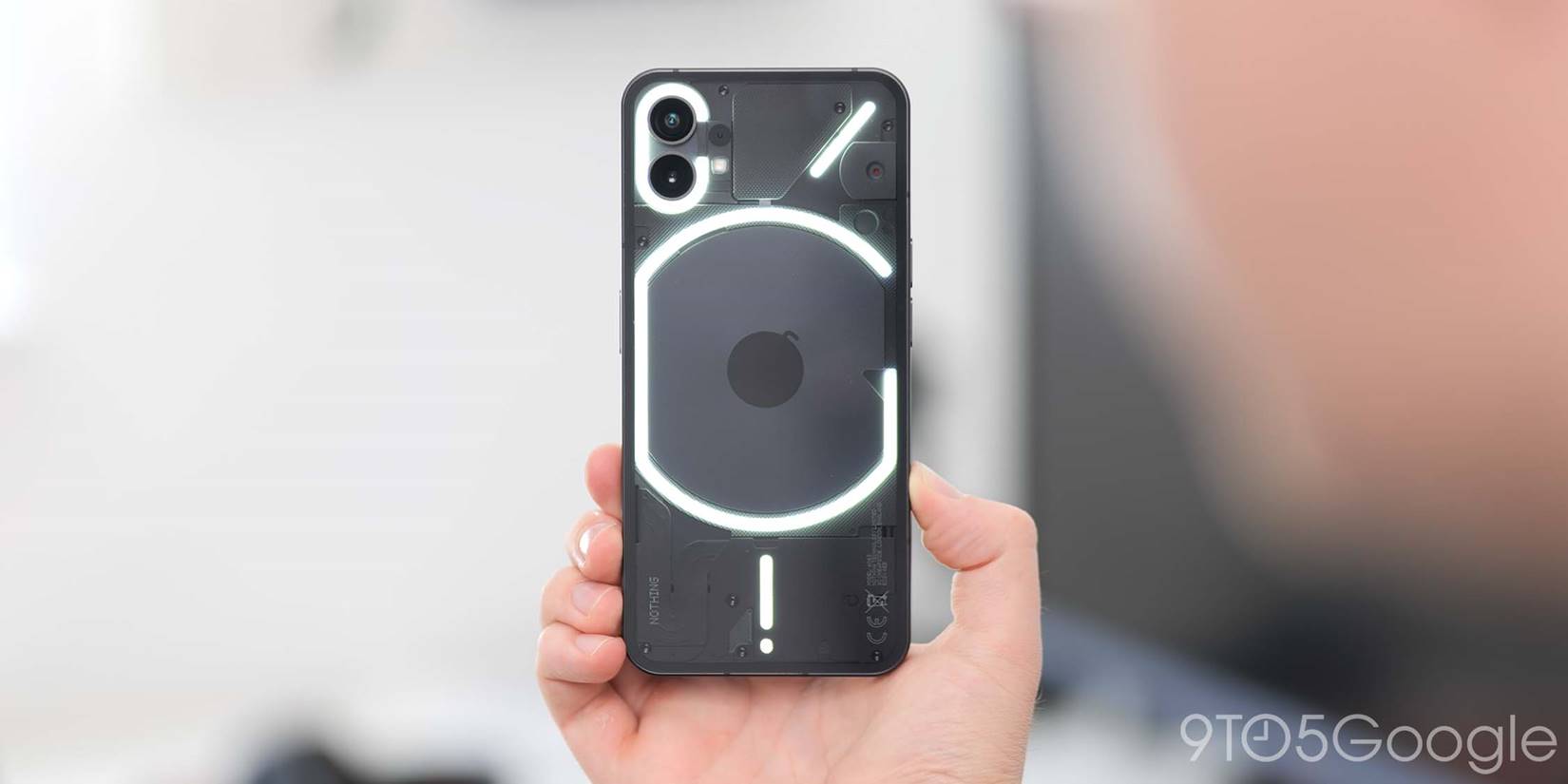
As a mid-ranger, the Nothing Phone (1) is not the flagship that many hoped for, but with a comparable spec sheet and price to the Pixel 6, we’re here to examine where they stack up against one another.
Given the big shift from Google back into the flagship arena, the Pixel 6 is the first rung on the ladder to where the series has previously pitched. While the Nothing Phone (1) is certainly no “flagship killer” it certainly has a lot to offer at an affordable price point. We’ve spent time with both (side-by-side) to see which you should choose and why.
Table of contents
Video – Nothing Phone (1) vs. Pixel 6
Thanks to Casetify for sponsoring 9to5Google on YouTube!
Hardware
Mid-range smartphones often bridge the gap between the low-end and the high-end. In recent years, the lines are becoming more and more blurred. The Nothing Phone (1) and Pixel 6 are prime examples of this.
Hold either phone, and it’s you’d be surprised that neither handset is an outright flagship in the traditional sense. The materials used almost do not suit the price tag associated with each phone and that is a very good thing. When you spend your hard-earned money, you want great quality hardware and it’s certainly true of the Nothing Phone (1) and Google Pixel 6.
While the Pixel 6 is not quite a top-tier Android phone, it provides just a bit more under-the-hood power than the Nothing Phone (1) can offer. The differences you’ll notice day-to-day are fairly minimal but the Pixel 6 certainly feels smoother. The Snapdragon 778G+ and Google Tensor processors are not lightyears apart but the Phone (1) does have a higher RAM option which should help with the longevity of this mid-ranger.


Save the chipset though, things compare quite well with the 120Hz AMOLED on the Phone (1) being marginally smoother and larger than the Pixel 6. It’s tougher to decide which is the better panel overall, as there are quirks to each to consider.
| Nothing Phone (1) | Google Pixel 6 | |
| Size | 6.55-inches | 6.4-inches |
| Display | 120Hz / FHD+ / Gorilla Glass 6 | 90Hz / FHD+ / Gorilla Glass Victus |
| Chipset | Qualcomm Snapdragon 778G+ | Google Tensor |
| RAM | 8/12GB | 8GB |
| Storage | 128 / 256GB UFS 3.1 | 128 / 256GB UFS 3.1 |
| Battery | 4,500mAh | 4,614mAh |
| Rear Camera | 50MP wide / 50MP ultra-wide | 50MP wide / 12MP ultra-wide |
| Front-facing camera | 16MP | 8MP |
| Biometrics | In-display fingerprint scanner / Face Unlock 9 (software-based) | In-display fingerprint scanner |
| Colors | White, Black | Sorta Seafoam, Kinda Coral, Stormy Black |
If you like the design of the Nothing Phone (1), you better like monochrome colors. The device is only available in black and white. The clear glass panel at the rear is not truly clear but covers and caps over the intricate electronic parts. If you want fancy LED lighting, then this is one of the few to utilize light strips so extensively as part of its “look.” Conversely, the Pixel 6 comes with one of the most unique-looking smartphones of the past few years with the camera bar and design influenced by previous Pixel releases.
Software

It’s a little more complicated to truly separate the software experience on Nothing Phone (1) and the Google Pixel 6 because of the volume of similarities between the super light Nothing OS skin and Android 12 on Pixel.
We’ve done a deep dive into the major differences but these boil down to the Glyph lighting and more major tweaks to the Quick Settings panel rather than major overhauls — as you’ll likely see on other Android skins. If you want a daily experience that is about as close to Pixel as possible, then the Nothing Phone (1) might be a perfect alternative.
You lose out on a host of Pixel-exclusive features such as Magic Eraser, On-device Live translation, and day-one software updates. Nothing does offer software-based Face Unlock though alongside a fingerprint scanner and has promised prompt support for its first phone but we’ll just have to wait and see how that plays out.
| Nothing Phone (1) | Google Pixel 6 | |
| Software | Shipped with Android 12 | Shipped with Android 12 |
| Features | Glyph lighting Material You Tesla integration NFT widget support Face Unlock | In-display fingerprint scanner Magic Eraser Face Unblur Motion modes On-device Live translation |
Nothing is promising 3 OS upgrades and 4 years of bi-monthly security patches as standard for the sub-$500 smartphone. This is leapfrogged by the Pixel 6’s three full OS upgrades and five years of regular monthly patches but both will be eligible for up to and including Android 15 when it does eventually arrive at some point in 2024.
Battery

The battery capacities on the Phone (1) and Pixel 6 are really similar but the latter has the edge here too. In real terms, the lifespan of the duo are fairly comparable once again. Because Google placed charging speed caps even with the official 30W wired charger, the Nothing Phone (1) has faster wired top-up options available with a Quick Charge 4.0 compatible power brick and USB-C cable.
An altered Snapdragon 778G+ also means that wireless charging and reverse wireless charging are also available on Nothing Phone (1). Ordinarily, the chipset is not capable of wire-free power but you do get standard 15W Qi charging and 5W reverse wireless charging for your accessories.
| Nothing Phone (1) | Google Pixel 6 | |
| Battery size | 4,500mAh | 4,614mAh |
| Charging speed | 33W wired 15W Qi wireless 5W reverse wireless | 30W wired 21W Qi wireless w/ Pixel Stand 2 5W reverse wireless |
The same is available to the Pixel 6, but with the Pixel Stand 2, you can access marginally faster 21W wireless charging speeds. Given that wired speeds are capped at 21W, the top-up times via wire favor the Phone (1) but if you prefer wireless charging and are willing to pick up an added accessory, the Pixel 6 is the better buy.
Cameras


The cameras on the Pixel 6 and Nothing Phone (1) share some common traits with 50-megapixel sensors at the heart of the setups on both devices. However, Phone (1) pairs a decent main sensor with a similarly specced ultrawide.
Where the Pixel 6 excels is in the software processing with the ISOCELL GN1 sensor. Not only is the sensor physically larger, Google’s post-processing magic means arguably better image potential even with pixel-binned images. The berth in quality is less pronounced with the ultrawide.
Although the specifications favor the Nothing Phone (1), Samsung’s JN1 sensor can be soft and unreliable at times. That is certainly true of the Phone (1)’s ultrawide with a lower resolution 12-megapixel ultrawide.
| Nothing Phone (1) | Google Pixel 6 | |
| Main sensor | Sony IMX 766 50MP f1.9 aperture | Samsung GN1 50MP f1.9 aperture |
| Secondary sensor | Samsung JN1 50MP ultra-wide-angle f2.2 aperture 114˚ FOV | Sony IMX 386 12MP ultra-wide-angle f2.2 aperture 114˚ FOV |
| Front-facing sensor | Sony IMX 471 16MP f2.5 aperture | Sony IMX 355 8MP f2.0 |
| Camera hardware features | OIS EIS PDAF | OIS EIS PDAF |
| Camera software features | Night Mode HDR video (1080p 30fps) 4K UHD 30fps Glyph fill light Expert mode Portrait mode | Night Sight Portrait Portrait Light 4K UHD 60fps Live HDR+ Video Cinematic Pan Locked Focus Active mode |
If you want extra modes and camera functions, neither device is feature packed. However, the Pixel 6 edges the Nothing Phone (1) courtesy of deeper video options alongside Tensor-powered post-processing modes such as Cinematic Pan, Locked Focus, and Active modes. Phone (1) does have an “Expert Mode” that lets you access manual controls, something that no Pixel device has ever offered so far.
For point and shoot photography, you’re served well but the Pixel 6 is far better across the board and even without a telephoto zoom lens, is among one of the best smartphone cameras on the market today.
Nothing Phone (1) vs Pixel 6: Which should you pick?

About upgrading: 9to5Google often gives specific product recommendations. Sometimes, we may suggest not upgrading, due to various reasons including, but not limited to: increased device cost, negligible performance gains, or environmental impact. Whether to upgrade is always your call, but our aim is to help you make as informed a decision as possible.
Despite hype levels way beyond where they should be for a mid-ranger, it’s hard not to be impressed by the Nothing Phone (1). It’s an interesting Android phone that comes with a good update schedule, clean software, and a steady camera setup. Is it a better buy than the Pixel 6? At least in most areas, no. Of course, if you’re in the United States you only have one option to choose and we’d wager that is the right one regardless.
The Pixel 6 best the Nothing Phone (1) in enough areas to make it a better overall buy. Design is subjective, but these are two of the most striking phones on the market today. One is a mid-ranger, the other a low-end flagship. In day-to-day use, they appear to meet somewhere in the middle.
As noted, limited availability in some markets means an easier choice. If you are worried that you’re missing out, don’t be. While the Nothing Phone (1) is a solid mid-ranger it certainly is not groundbreaking.
More on Android:
- Google is addressing Android’s power management issues with community help
- How to downgrade from Android 13 Beta 4 back to Android 12 on Google Pixel [Video]
- Here’s Google’s new ‘Switch to Android’ app for iPhones [Update: All Android 12 phones]
FTC: We use income earning auto affiliate links. More.


Comments